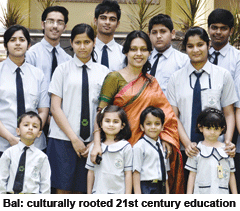 Once upon a time even the most avant garde and progressive K-12 schools were teacher-centric. The teacher was the focus of all attention. She stood at the head of the class, and children listened and did as they were told.
Once upon a time even the most avant garde and progressive K-12 schools were teacher-centric. The teacher was the focus of all attention. She stood at the head of the class, and children listened and did as they were told.
However during the past few decades and especially since the dawn of the new millennium, there’s been a global mindshift in favour of student-centric education. Deep research into the human brain, in behavioural sciences, and class-room pedagogies has created widespread awareness that participative and interactive classrooms in which the teacher is a co-learner and facilitator who uses perception, creativity and intuition to make lessons interesting, motivating and synergistic — deliver the best learning outcomes. Suddenly there’s dawning awareness of the accuracy of the Chinese proverb — “I hear and forget, I see and remember and I do and understand.”
Gradually — perhaps too gradually — the teachers’ community worldwide has become conscious of the importance of hands-on learning through comprehension rather than traditional rote and memorisation pedagogy. It’s becoming increasingly evident that encouraging students to undertake research and project assign-ments independently with facilitation, aid and advice provided by teachers, arouses their interest and discovery which remains with them life long, whereas memorised learning fades. These days the best teach-ers make lessons theme-oriented and support class-room teaching with new ICT (information communi-cation technologies) which enable thorough compreh-ension and interest in learning and transform students into confident and independent learners.
However although teaching children to learn through comprehension and project assignments delivers better learning outcomes, there’s no denying it’s more time consuming. And given high teacher-pupil ratio conditions of most Indian schools, classroom environments tend to be less than conducive for teachers obliged to complete assigned syllabuses. Therefore the time and patience available to make all students thoroughly understand and grasp lessons is limited. Under the prevailing circums-tances, it would be in the national interest for syllabus-framers to limit the breadth and scope of syllabuses, and bear in mind that core concepts taught in a child-centric style are better learnt than wide syllabuses which require to be covered in speed.
Contemporary teaching-learning also requires traditionally stern, impersonal teacher-student relationships to be replaced with warmer, empathetic relationships which have a positive impact on students’ academic, social and personal develop-ment. Building an effective and supportive student-teacher connection results in higher levels of academic and personal achievement. When a student feels personally connected, receives guidance and praise rather than criticism, she is likely to respond by way of better classroom behaviour and learning outcomes. This imposes an important and onerous responsibility upon teachers to transform themselves into role models from whom impressionable students can derive personal development inspiration.
Peculiar classroom conditions prevalent in K-12 education in India also require burdened teachers to devise innovative solutions to cope with crowded classrooms, problem children and parental expectations in terms of academic excellence. One such solution is to encourage ‘peer’ or collaborative learning, a primary-secondary education system which was pioneered in India but fell into disuse with the dawn of the British raj and has remained so ever since. Under this system, a class is broken into small groups of eight-ten students, each mentored by a quick-learner student leader. These groups learn collaboratively under peer pressure conditions led by class leaders and under the overall supervision and facilitation of subject teachers.
Another option available to the overburdened teachers’ community is to encourage self-study and learning. With latter day students having access to the vast library that is the worldwide web and the internet, intelligent teachers can substantially reduce workload and stress by kindling students’ interest in a subject and encouraging self-study and discovery. But to encourage self-study, schools need good libraries — a blindspot of Indian education. Therefore teachers need to actively plead the case for well-stocked libraries equipped with broadband connectivity.
Quite clearly, the role and character of 21st century school teachers has undergone a paradigm shift. With students having become smarter and internet savvy, the era when teachers were acknowledged as fonts of wisdom on the basis of unchanged notes and pedagogies of yesteryear is over. Now there is greater onus on teachers to be on top of the latest developments in their area of expertise and nurture students to truly comprehend concepts and subjects while experiencing the joys of learning. It’s an onerous responsibility which our community needs to confront with honesty in the wider interest of our students and society.
(Dr. Mona Lisa Bal is chairperson of KiiT International School, Bhubaneswar)